Who will win the race to State House
On paper, President Adama Barrow is the candidate to beat. He has consistently led in the polls. He enjoys the support of a grand coalition; one bigger than the group that backed him to victory five years ago, at least in terms of the number of political entities. If each of the coalition partners pulled their weight, Barrow will not be within sight of his opponents.
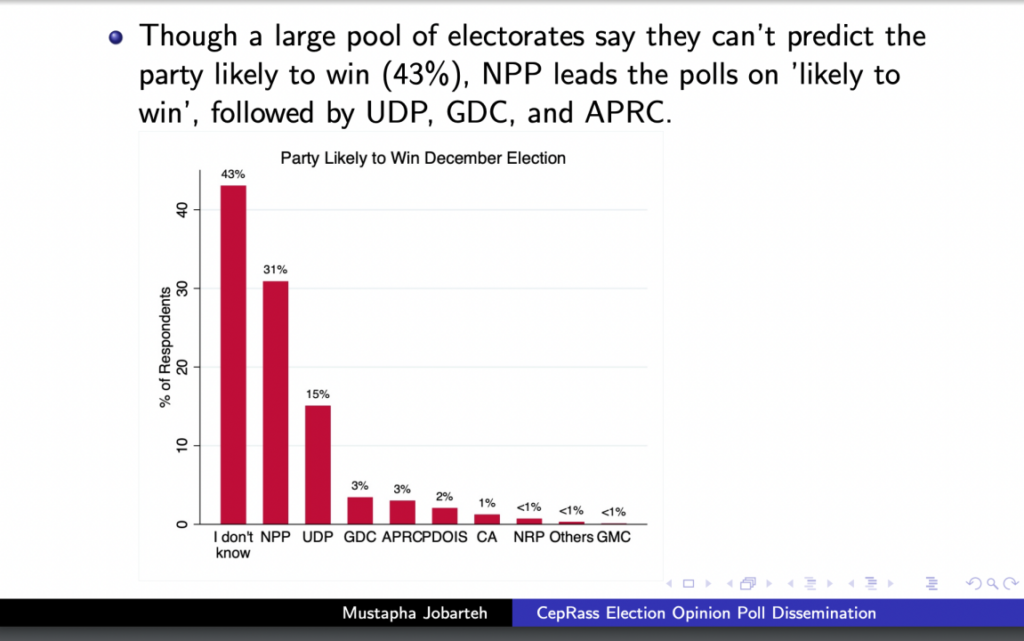
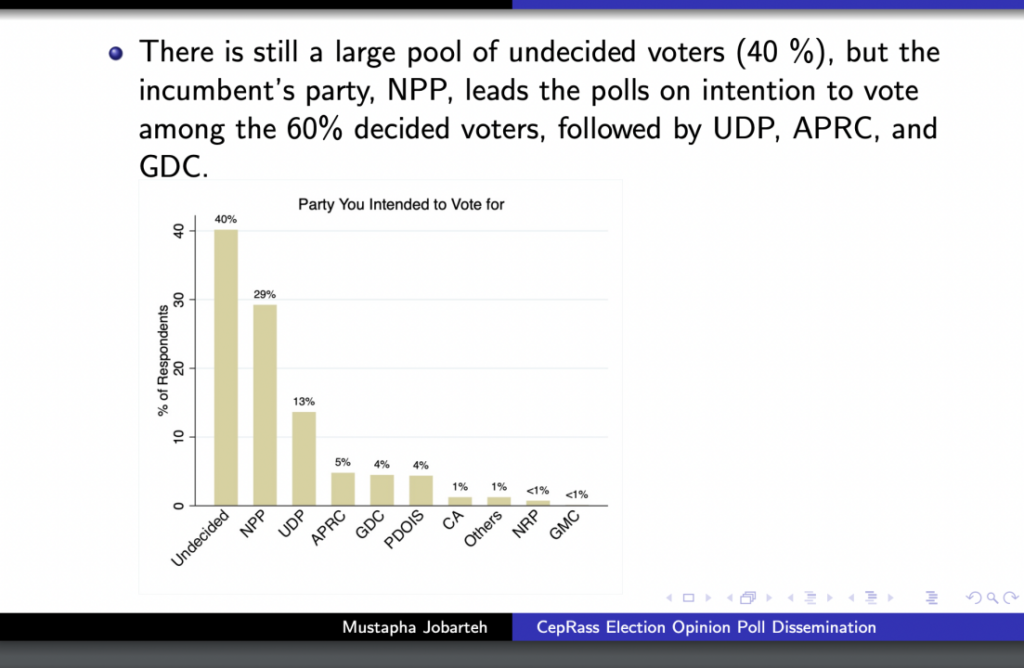
However, what will happen on the ground could be different. The eleventh-hour resurgence of PDOIS’ Halifa Sallah and GDC’s Mama Kandeh as well the incursion of newbie Essa Faal into what is supposed to be a Barrow heartland, may spell doom for the incumbent.
That is besides the main point. No longer unbridled by the jaws of dictatorship, the UDP beast has been unleashed; lurking, and threatening. The party has a political base caged in iron gates. It has also gone through significant reforms, attracting voters that have traditionally voted against the party. And, being in control of regional governments while enjoying a majority in parliament, it should come neither as a shock nor a surprise if Darboe is declared winner. After all, only one party, the UDP, has a utility man. Momodou Sabally – remember this name should UDP win.
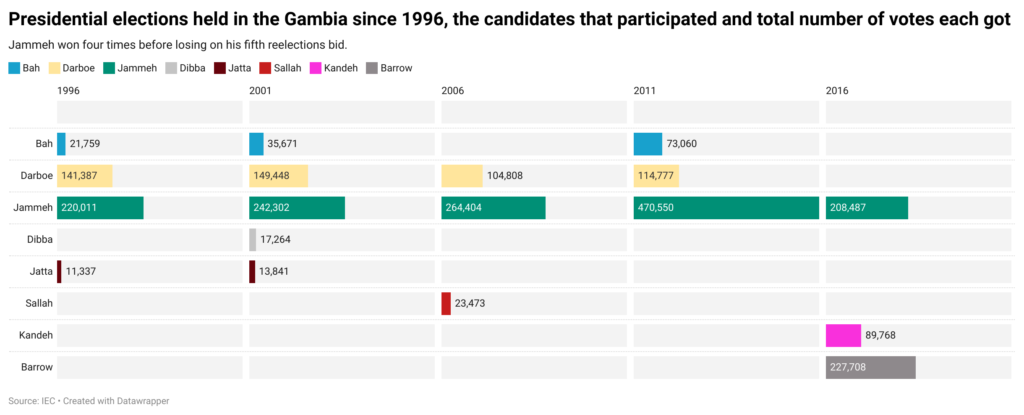
The APRC struggled against the UDP in the first two outings following the restoration of multi-party politics and a new constitutional order. The party had a consistent rise, widening the margin in style in 2011, when Jammeh bagged whopping 470,550 votes, compared to his rival Darboe’s 114,777. Five years later, Jammeh lost to an opposition coalition in 2016.
The main rival party, UDP, had been led by Ousainou Darboe in all the previous four attempts – 1996, 2001, 2006 and 2011. Darboe’s performance has not been consistent, except in terms of losing to APRC’s Yahya Jammeh. His votes significantly reduced in 2006 despite forming an alliance with NRP in 2006. He recouped some of the loss in 2011, after leading a three-party coalition called United Alliance (UDP, GMC and NCP), but never returned to his former glorious days of 2001.
PDOIS under its previous presidential candidate Sidia Jatta has performed underwhelmingly in 1996 and 2001. In 2006, the party led NADD, a three-party alliance (PDOIS, NDAM and GPDP). Halifa Sallah managed get an increased vote of 23,473, emerging a distant third from Darboe’s 104,808 and Jammeh’s 264,404.
In 2016, new political leaders emerged. Darboe was in jail, Bah, Jatta and Sallah, who participated in the previous elections threw their weight behind Barrow as candidate for the coalition. It was his first time. So was it for Kandeh of GDC. This leaves President Jammeh as the only candidate with history of contesting in the presidential elections.
Barrow and Kandeh are from the same constituency. The two faced off early in their political career for parliamentary seats in their native Jimara area. Kandeh, vying under the ticket of his former APRC party, won Barrow of UDP. Barrow would get his revenge in 2016, defeating both Mama and his former boss, Yahya Jammeh.

President Barrow and NPP
President Adama Barrow, backed by a united opposition front, surprised the world when he defeated Yahya Jammeh, who held strongly onto power for twenty-two years. He is going into this election with the advantages of being incumbent while campaigning in full view of his deliverables. The roads and bridges built in the past five years put him as favourite especially in the rural Gambia. He may however be punished for the high cost of living, increased crime rate and undermining of democratic reforms and transitional justice programme initiated by his government. His opponents question his competence.
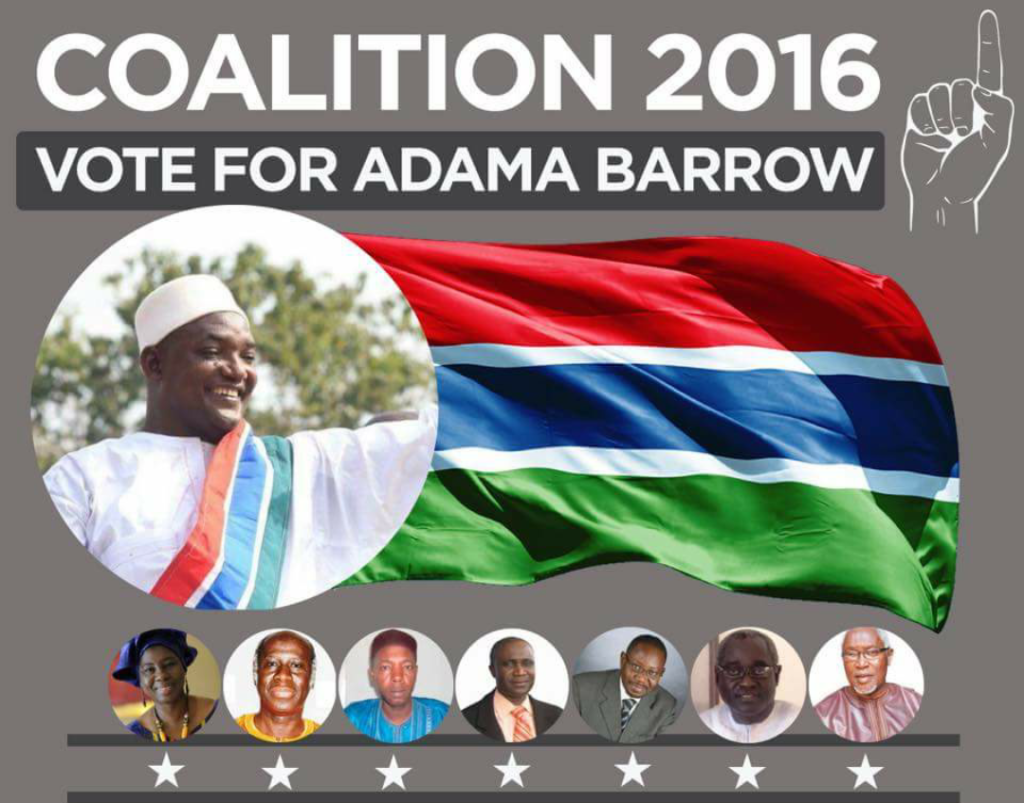
However, the coalition that backed him to victory has disintegrated. Two major parties UDP and PDOIS and a lesser one, GMC, have been pushed out, leaving smaller and lesser influential parties such as NRP, GPDP, PPP and NCP.
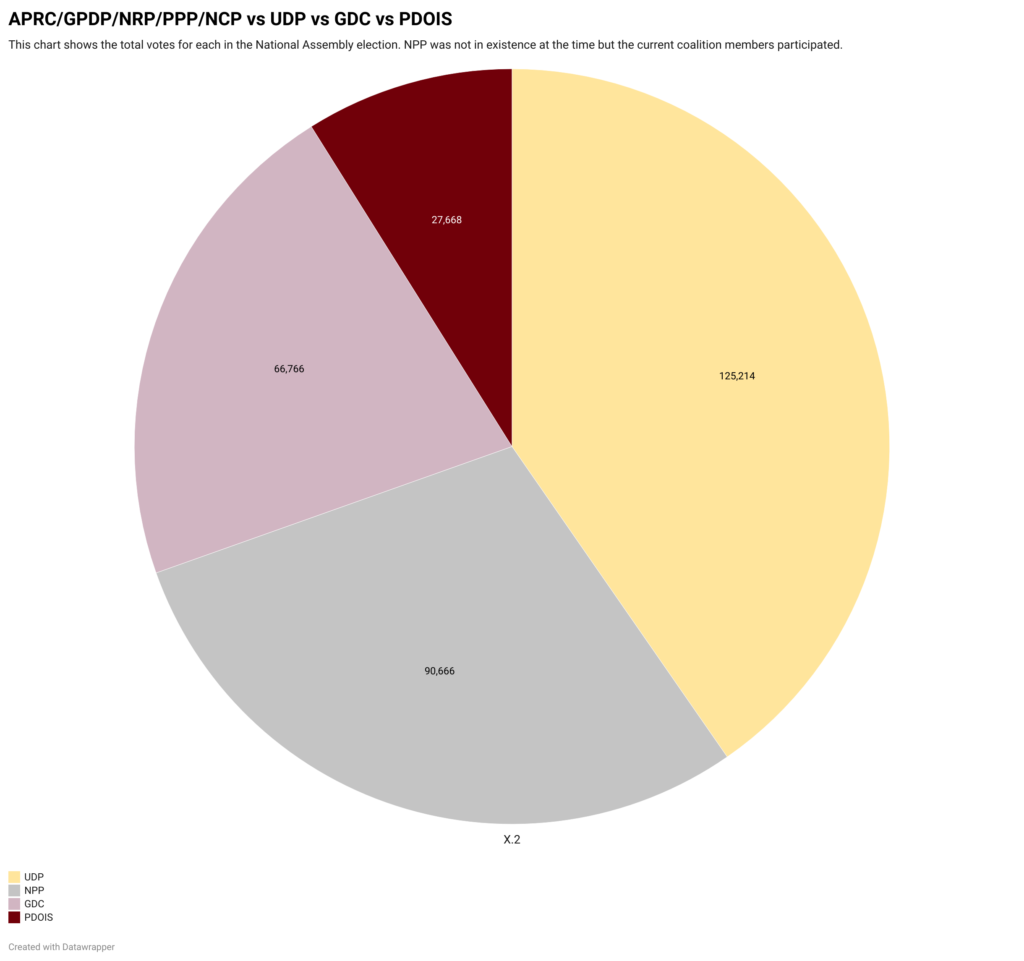
Nonetheless, since forming his NPP in December 2019, President Barrow organically subsumed the parties that remained in the coalition. He eloped with a faction of the UDP and attracted significant number of voters from existing political parties. The jewel in his crown is the APRC, a controversial alliance that may see him punished by a section of the society.
All things being equal, victory was a forgone conclusion for Barrow with APRC. Trouble though is that the feast over the meal that is APRC was over before the former heavyweight threw its weight behind President Barrow. APRC’s popularity took a dramatic 60-degree nosedive plunge after the 2016 defeat. This was so serious that the party could field candidates in only three out of possible seven in the mayoral/chairperson elections, bagging only 42, 643 votes, out of 257,506 votes cast. Analysis of the results show that the core of what is left of the party after the 2016 defeat now forms the base for the NAM – No Alliance Movement, a Jammeh-backed splinter group that supports GDC’s Mama Kandeh.
The UDP might have more control over the regional governments but put together, Barrow has equal control in the National Assembly. The man that won the Kuntaur seat for the GDC has also switched allegiance to President Barrow. A hard-to-count number of local councillors are also onboard the Barrow Bus.
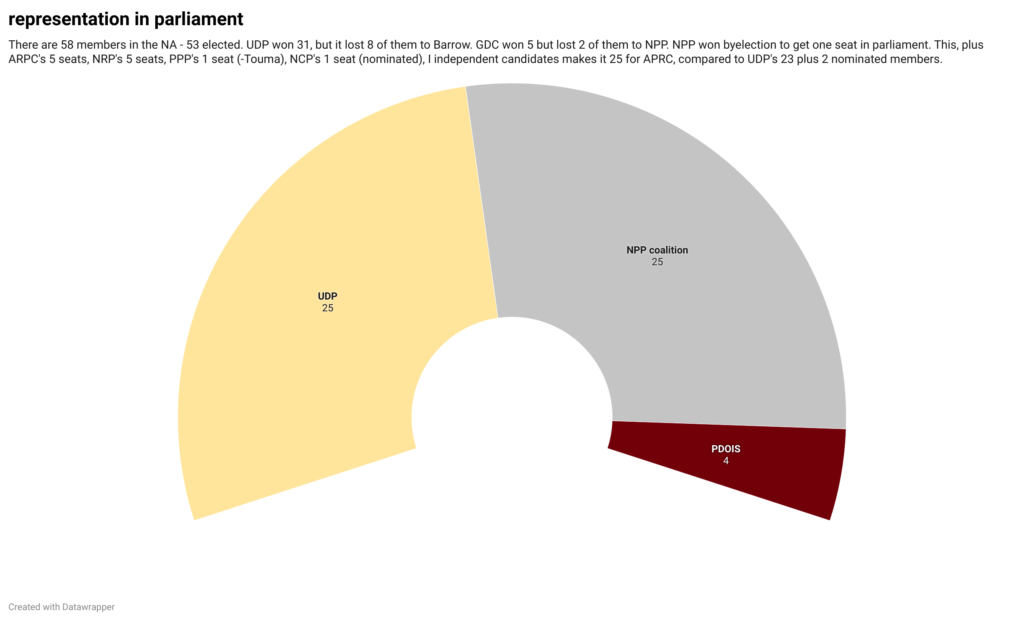
Ousainou Darboe of UDP
This is Darboe’s fifth – and quite surely – his last shot at the presidency. In his heydays under the dictatorship, he came quite close to winning the presidency. In fact, according to him, he lost because he was cheated.

UDP’s best performance came in 2001. Darboe got 32% of the votes while Jammeh’s percentage reduced to 52%, from 55% in 1996. The party however boycotted the 2002 parliamentary elections. In the subsequent presidential elections, it underperformed terribly despite joining forces with NRP. The mystery here is that Darboe got 149, 448 votes while Hamat Bah got 35,671 in the previous elections. The alliance should have guaranteed at least 185,000 votes. It was more than 80,000 votes less.
The UDP is largely in control of the local governments. The party has massively outperformed others in both the National Assembly and local government elections.
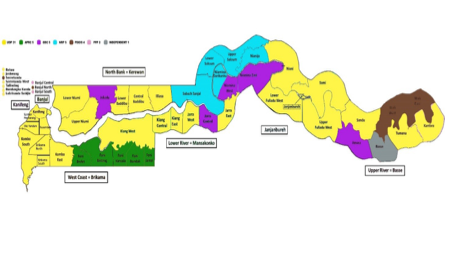
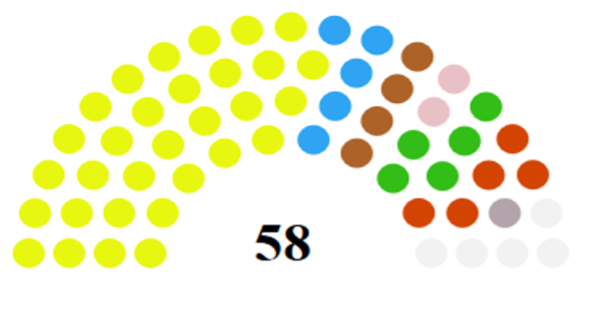
Take the mayoral elections as another example. Besides winning six out of seven positions being contested, the party’s votes across the country was 121,746. This is six thousand more votes than what the party and Darboe pulled in 2011 presidential election, a indication of the growth registered by the party since the change of government.
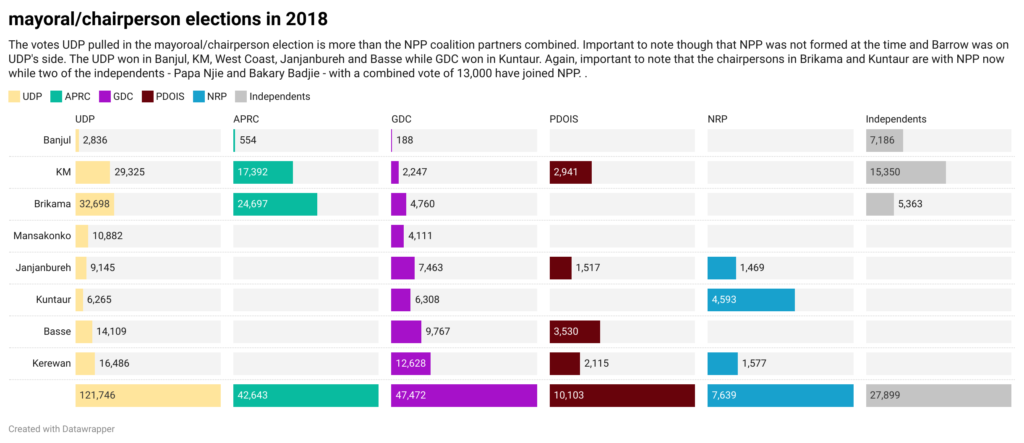
Analysis of the National Assembly and local government election results show that the UDP has made inroads in hitherto no-go areas while consolidating their support in their heartlands. Take Foni Bondali for example. At the height of his popularity in 2001, Darboe got only 142 votes there. This did not change much in 2016. Barrow and the coalition too got only 193. In the National Assembly elections that came barely five months after Jammeh’s defeat, the UDP put up a candidate in Bondali, pulling 828 votes. Similar trend is observed in all the five Foni constituencies, one of the weakest areas for the party.
It must be pointed out that at this point, the UDP enjoyed considerable level of advantage. It may not be in complete control over the government, but it has taken ownership of the presidency.
Mama Kandeh, GDC
Mama Kandeh was generally regarded as the spoiler for Jammeh in the 2016 polls. Will he be the same for Barrow? Or, will he emerge victorious?

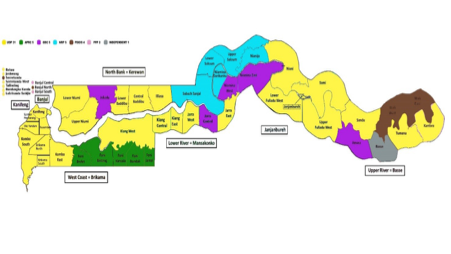
The GDC emerged third in the 2016 election. Mama bagged a stunning 89,768 votes. This is way higher than any opposition leader besides the UDP’s Darboe. What is more impressive about Mama’s volume of votes is that it was without the backing of any candidate or party, compared the alliances under which Darboe, Halifa and Hamat competed.
In the National Assembly elections, the party competed in all the constituencies, except in Foni Kansala. The GDC has fielded more candidates than any other party, including the UDP. This is indicative of the strength of the party.
Halifa Sallah, PDOIS
PDOIS has been in the field at least ten years before any of the political parties competing in this year’s election. Sidia Jatta contested a parliamentary elections in presidential elections in 1992 under the First Republic and in 1996 and 2001 under the Second Republic. The performance was underwhelming.
But that looks less likely. Going by the voting patterns, campaign crowds and demographics, this is a race between the NPP and UDP. The election will not be decided by the undecided voters. The margin will likely be razor thin. With Darboe and Barrow each likely to win in 4 regions, you can guess what will make the difference and who is likely to be declared winner.
In 2016, PDOIS led a coalition of three parties (previously five as UDP and NRP pulled out of it to form an alliance) called NADD. The performance of Halifa was a slight improvement on Sidia’s. He got 23,473 votes, compared to Sidia’s 13,841 in 2001.
PDOIS is widely credited for putting together the coalition that defeated Jammeh in 2016. In the following year, the party participated in the National Assembly elections, fielding candidates in 22 constituencies, out of possible 53, winning only four seats.
During the local government elections, PDOIS contested in four out of possible seven constituencies, securing no seat while bagging 10,103 votes.
Conclusion
Polls indicate a significant margin in terms of the undecided voters. This is something that parties like PDOIS and Essa Faal, an independent candidate will be hoping to get. If what is in the polls turns out to be the reality of the ground, the election is wide open for anyone to win.
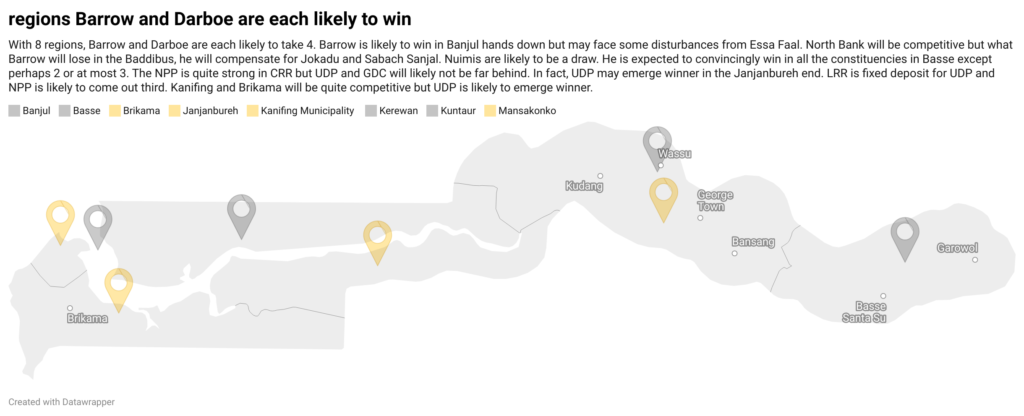
But that looks less likely. Going by the voting patterns, campaign crowds and demographics, this is a race between the NPP and UDP. The election will not be decided by the undecided voters. The margin will likely be razor thin. With Darboe and Barrow each likely to win in 4 regions, you can guess what will make the difference and who is likely to be declared winner.
Malagen is supported by NED to carryout comprehensive coverage, including investigations with respect to the election

